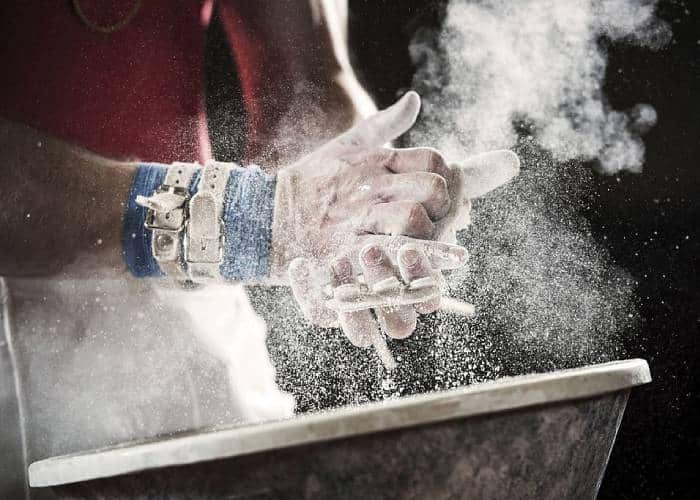Jump to:
The Gym Rat’s Guide To Gym Chalk
When it comes to fitness, do not underestimate the importance of grip strength and longevity. You can have a strong-enough back or shoulders to sustain heavy deadlifts or rows, but what if your grip wavers before these muscle groups even get a chance to properly activate?
Gym chalk can help you sustain a proper grip and reduce the chances of a failed rep. What is it and how exactly can it improve your lifts? In this article, we’ll go over what gym chalk is used for, why you should be using it, and the different types you can use.
What Is Gym Chalk?
Gym chalk or lifting chalk is a substance that’s used to improve grip power and longevity. It’s made of a chemical called magnesium carbonate, which absorbs moisture quite effectively.
Hand chalk for the gym is different from regular classroom chalk which is made of calcium carbonate – this chemical can heavily irritate your eyes and skin. Magnesium carbonate, on the other hand, is much safer, causes less irritation, and is insoluble in water. This means that it’s much more efficient at absorbing moisture from sweaty hands.
Lifting chalk is also different from baby powder. While the latter also absorbs liquids, much like its chalk counterpart, it’s not as effective at increasing friction between your grip and the barbell. On the contrary, powder will make the barbell feel a bit slippery.
Gym chalk is commonly used by CrossFitters, powerlifters, and weight lifters to keep them from losing grip throughout lifts, so they can lift safely. It’s also used in rock climbing and gymnastics.
Types of Gym Chalk
If you’re on the market for chalk, you’ll likely see a wide range of names, such as lifting chalk, gymnastics chalk, and rock climbing chalk. To make it easier, let’s categorize them down into two types:
Dry Chalk
Dry chalk, also called powder chalk, is made of a substance called magnesium carbonate. It comes in either gym chalk block or powdered form, which you can easily apply by covering your hands in it.
Liquid Chalk
Liquid gym chalk is also made of magnesium carbonate, just like its powder chalk counterpart. However, the difference is that it also includes other components like alcohol and water that make it easy to apply on your hands, like a liquid. After a few moments, the alcohol will evaporate, resulting in a more even spread.
What Is The Best Type Of Hand Chalk For The Gym?
It’s hard to say which of these is the best gym chalk for you. It all boils down to convenience and preference.
For example, rock climbers typically prefer dry chalk because it can be easily stored in a chalk bag. Many lifters, on the other hand, might prefer liquid chalk because they apply much more evenly.
Whatever type you choose, just make sure you don’t get regular chalk.
Do I Need Gym Chalk?
If your fitness program includes any exercises that require any substantial grip power, then you should consider using chalk.
For example, CrossFit programs usually incorporate heavy lifts like clean-and-jerks or deadlifts, as well as several types of pull-ups that require you to hold on to a bar for a sustained amount of time. Exercises like these have gravity more intensely working against you and will test your grip much more than others.
To help with this, some people use weight lifting gloves. Gloves do offer a certain level of sweat absorption and protection from skin tears. However, the added barrier increases the diameter of the barbell which can affect your grip. Additionally, gloves can get stinky, sweaty, and worn out over time.
Gym chalk is the better alternative as it’s more hygienic. It also allows you to have direct skin contact with the bar so you minimize any loss of sensory awareness that could inhibit your performance.
So, if you’re into any sort of lifting or any other sports that test your grip strength, it’s highly recommended that you use gym chalk.
Benefits Of Gym Chalk
Helps Prevent Injuries
Applying lifting chalk helps prevent injuries that are sustained from using additional movements unnecessary to the lift. Let’s illustrate:
Let’s say you’re doing a shoulder press, and the barbell is at its highest position above your head. If you feel that you’re starting to lose grip, you might try to compensate by bouncing the bar in your palms. This puts unnecessary stress on your joints, which, if repeated over a long period, can cause long-term injuries. Additionally, doing any unnecessary movements during lifts makes you more prone to breaking barbell form and getting injured.
Using chalk minimizes the chances of losing your grip. In turn, it reduces the risk of injury from trying to sustain your grip.
Lift Heavier For Longer
When doing compound lifts, the smallest muscle groups are likely to give out the earliest. Your grip strength is primarily connected to your wrist and forearm muscle groups – these two groups are much smaller compared to, for example, your back or shoulders.
Let’s say you’re doing deadlifts. You can have an extremely strong back to support the movement, but you’ll likely drop the weights in mid-rep as soon as your grip wavers.
If you apply chalk to your hands, your grip will be better, and you’re more likely to complete your reps. And the more consistent you are with your lifts, the better your workout overall.
Final Thoughts
Sometimes, the difference between a failed and a successful rep is something as simple as having the right grip. Whether liquid or powder chalk, this simple product is a must-have in your workout kit. Not only does it help you sustain lifts for longer, but it also prevents injuries from an incorrect grip. That’s because gym chalk is made of a special chemical compound that absorbs sweat effectively, helping you keep your hand on the bar – where it belongs.















